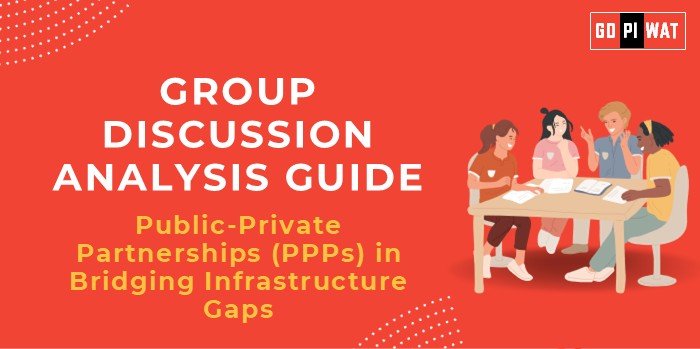📋 Group Discussion (GD) Analysis Guide: Public-Private Partnerships (PPPs)
🌐 Introduction to the Topic
Opening Context: “As developing nations grapple with a $15 trillion infrastructure investment gap by 2040, public-private partnerships (PPPs) have emerged as a transformative model for sustainable development.”
Topic Background: Public-private partnerships combine government and private sector strengths to address critical infrastructure needs, from transportation to energy, with promising results globally.
📊 Quick Facts & Key Statistics
- 🌍 Global Infrastructure Gap: Developing nations face a $15 trillion investment gap by 2040 (Global Infrastructure Outlook).
- 📈 PPP Growth: PPP projects increased by 20% globally between 2018 and 2022, with 75% targeting developing nations.
- ✅ Success Rate: 60% of PPPs in developing countries achieve on-time completion and operational sustainability (World Bank).
- 💰 Private Investment in Africa: $100 billion in private investments through PPPs between 2010 and 2022, primarily in energy and transportation.
🤝 Stakeholders and Their Roles
- 🏛️ Governments: Create legal frameworks, offer subsidies, and ensure equitable service distribution.
- 💻 Private Sector: Provide funding, expertise, and operational management for infrastructure projects.
- 🌐 International Institutions: Facilitate funding, capacity building, and risk mitigation strategies.
- 👥 Citizens: Act as end-users who assess the accessibility and quality of services delivered through PPPs.
📚 Achievements and Challenges
🏆 Achievements
- 💡 Energy Expansion in Africa: $50 billion directed to energy, boosting access by 30% between 2010 and 2022.
- 🚉 Transportation Development: PPP projects delivered 1,000 km of railways in Southeast Asia since 2018.
- 📈 Improved Efficiency: 60% of projects completed on time and operationally sustainable.
⚠️ Challenges
- 📜 Policy Uncertainty: Legal hurdles deter private investment.
- 📉 Lack of Transparency: Some PPP models lead to public mistrust.
- 🌍 Access Disparities: Rural areas often face limited benefits from PPPs.
📖 Case Studies
- 🇮🇳 India: Hyderabad Metro completed under a PPP, reducing urban congestion and emissions.
- 🌍 Africa: Senegal’s toll road PPP reduced travel times by 50%.
💡 Effective Discussion Approaches
📜 Opening Approaches
- 📊 Highlight global statistics, such as the $15 trillion infrastructure gap.
- 💰 Reference Africa’s $100 billion private investment success story.
- ❓ Pose thought-provoking questions about the role of PPPs in inclusivity.
🔄 Counter-Argument Handling
- ⚖️ If challenges such as high costs are cited, argue that long-term efficiency and savings offset upfront expenses.
📊 Strategic Analysis of Strengths & Weaknesses
- 🌟 Strengths:
- Efficient resource utilization.
- Access to private expertise.
- Faster project delivery.
- ⚠️ Weaknesses:
- Dependence on private funding.
- Public backlash over pricing concerns.
- ✨ Opportunities:
- Green infrastructure initiatives.
- Smart city developments.
- ⚡ Threats:
- Political instability.
- Project delays.
🗣️ Structured Arguments for Discussion
- 👍 Supporting Stance: “PPPs unlock private capital to bridge critical gaps in public infrastructure efficiently.”
- 👎 Opposing Stance: “High privatization risks can exacerbate inequality and limit access to essential services.”
- ⚖️ Balanced Perspective: “PPPs succeed when supported by strong regulatory frameworks ensuring accountability and inclusivity.”
🎓 Connecting with B-School Applications
- 📘 Real-World Applications:
- Case studies on PPP financing models for infrastructure projects.
- ❓ Sample Interview Questions:
- “How can PPPs be made more inclusive in developing countries?”
- “Discuss the role of international funding in PPP projects.”
- 📖 Insights for Students:
- Analyze PPP case studies for finance and operations research.
- Explore innovative funding solutions like Viability Gap Funding (VGF).


